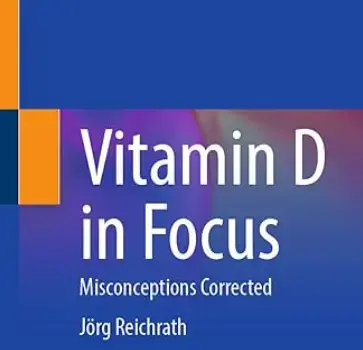Vitamin D in Focus - Misconceptions Corrected - book
Misconceptions corrected book

Rent from Amazon for $22 Translated from German, 143 pages
Table of Contents
1 Vitamin D and Health: Historical Considerations and Current State of Research 1
1.1 Misconception 1: Vitamin D is a Vitamin 3
1.2 Misconception 2: Because Rickets Has Largely Disappeared Today, Vitamin D Deficiency is No Longer Relevant to Health 5
1.3 Misconception 3: There is Scientific Evidence Refuting the Great Importance of Vitamin D for Health 30
2 Vitamin D Intake with Food 33
2.1 Misconception 1: Enriching Food With Vitamin D Has No Impact on Health and Therefore Makes No Sense .33
2.2 Mistake 2: Under Our Living Conditions, the Vitamin D Requirement Is Fully Covered by the Diet—Even Without Taking Dietary Supplements .... 37
2.3 Misconception 3: It is a Flaw in Evolution that Breast Milk Contains Everything Infants Need for Healthy Development—With the Exception of Vitamin D 40
2.4 Misconception 4: It is Necessary to take Vitamin D Together with Fatty Foods to Achieve Good Absorption in the Gastrointestinal Tract 42
3 UV-Induced Vitamin D Production in the Skin .. 45
3.1 Misconception 1: Vitamin D Can Be Produced in the Skin Without UV Influence 46
3.2 Misconception 2: Natural Sun Exposure Allows for Sufficient Vitamin D Production in Germany in All Seasons 47
3.3 Misconception 3: The Vitamin D Production of the Skin is Only Insignificantly Influenced by the Strength of the Ground-Level UV Radiation 49
3.4 Misconception 4: Skin’s Vitamin-D Synthesis is Not Influenced by Age 53
3.5 Misconception 5: The Synthesis of Vitamin D Lowers the Blood Cholesterol Level by Consuming Its Precursor 7-DHC 53
3.6 Misconception 6: The Skin Produces Only a Few Hundred IU of Vitamin D Daily, Even Under Sufficient UV-B Influence 54
3.7 Misconception 7: A Healthy Person Can Produce Too Much Vitamin D From Extensive Sunbathing and Thereby Endanger Health 56
3.8 Misconception 8: UV-B Irradiation of Dairy Cows Has No Effect on the Vitamin D Content of Cow’s Milk 58
3.9 Misconception 9: UV Irradiation of Food Has No Effect on Its Vitamin D Content 59
3.10 Misconception 10: The Impact of Changes in Our Vitamin D Supply on Vitamin D Status is Difficult to Estimate 60
4 Vitamin D, Skin Types, and Sunscreen 63
4.1 Misconception 1: The Various Human Skin Types are a Whim of Evolution Without Biological Significance—And also Without Relevance for Cutaneous Vitamin D Production .. 63
4.2 Misconception 2: A Mild Sunburn is Harmless to Health 65
4.3 Misconception 3: The Use of Sunscreen Does Not Reduce the UV-Induced Formation of Vitamin D in the Skin 68
4.4 Misconception 4: The Use of Sunscreens Poses No Health Risk 70
4.5 Mistake 5: The Use of Sunscreen Does Not Pose an Environmental Burden 79
4.6 Mistake 6: The Right Choice of Sunscreen Protects Against the Sun Without Reducing Vitamin D Synthesis 82
5 How Does Vitamin D Work? 87
5.1 Misconception 1: The Vitamin D Formed in the Skin or Ingested with Food is Biologically Active 87
5.2 Misconception 2: 1,25-dihydroxyvitamin D (1,25(OH){SUB()}2{SUB}D) is the Only Biologically Active Vitamin D Metabolite 88
5.3 Misconception 3: All Effects of Vitamin D Formed in the Skin Can Be Compensated by Oral Intake of Vitamin D 91
6 What is the Optimal Vitamin D Status? .... 93
6.1 Misconception 1: To Assess Vitamin D Status, the Blood Level of the Biologically Active Metabolite 1,25-dihydroxyvitamin D (1,25(OH){SUB()}2{SUB}D) Should Be Determined. If this Value is Within the Normal Range, There is No Vitamin D Deficiency 94
6.2 Misconception 2: The Determination of the Serum Concentration of the Biologically Inactive Vitamin D Metabolite 25-hydroxyvita- min D (25(OH)D) is Unsuitable for Assessing a Person’s Vitamin D Status 96
6.3 Misconception 3: An Optimal Vitamin D Status is Assumed When the Blood Level for 25(OH)D is Above 10 ng/ml and When there is No Indication of a Disease of the Bone and Calcium Metabolism ...... 98
7 Conclusion with Practical Recommendations for Ensuring Good Vitamin D Supply while Safely Interacting with the Sun 101
